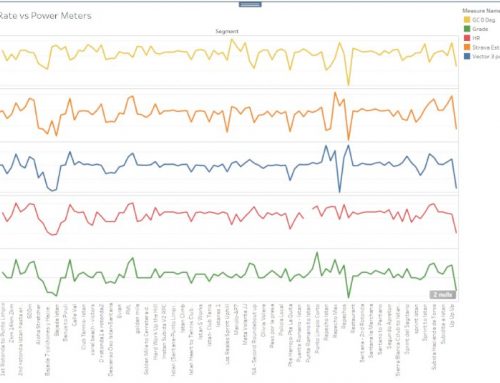Here’s a few thoughts from my time racing cars that I think are relevant to cycling and don’t seem to get a lot of coverage. They may not translate exactly between the two sports but I have found them useful and thought they were worth sharing.
Make sure your Bike is 100% safe
Don’t ride with equipment issues; make sure your bike is checked before every ride, you can’t cycle downhill at 60km worrying about that rubbing noise from the front wheel! Wheels and tyres are critical here as they are your only contact with the road!
Ride the shortest route unless riding further is faster
 The fastest time to ride from A to B at a set speed is the shortest. For example, if you ride a 6km circular course on a road that is 4 meters wide, then riding the inside kerb is 0.4% shorter than riding the outside kerb and gains you 100 meters over 25km.
The fastest time to ride from A to B at a set speed is the shortest. For example, if you ride a 6km circular course on a road that is 4 meters wide, then riding the inside kerb is 0.4% shorter than riding the outside kerb and gains you 100 meters over 25km.
The problem comes a) because you rarely ride around a perfect circle and b) Because the grip of you tyres determines your maximum speed around a given radius, meaning you may need to “open out” the corners which increases the distance you need to travel BUT means you can ride faster (You are only really likely to need to do this on descents).
To resolve these problems you need to look ahead through the corners and try to take the shortest line while at the same time opening them out enough to achieve the best compromise between speed and distance.
Increase your top speed on straights and maintain it for longer
The time it takes to ride the length of a straight is determined by how quickly you can get up to your terminal speed, and how long you can hold that speed. This means that what matters is your acceleration onto the straight and how late you brake. If you can ride at your terminal speed for an extra 20 Meters on a 5K straight you will enter the next corner 10 meters further down the road.
Drafting/Slipstreaming
This is a critical skill and well understood. There’s been so much written about this in the cycling community that I don’t need to comment further.
Aerodynamics
In motor racing, there is always a trade-off between aerodynamic efficiency and down-force which provides more grip at the expense of drag. In road cycling down-force is not an issue so all that matters is aerodynamic efficiency.
Drag Coefficient and Frontal Area
How slippery you are and how much frontal area you present makes a huge difference to your speed. Aerodynamic drag squares with speed so if you go twice as fast the amount of drag increases by a factor of four.
Contorting yourself into the perfect aerodynamic position might also adversely affect your power delivery by making it awkward to pedal.
For these reasons, your biggest improvements can be made on descents and there can be big gains here for almost no effort. It’s easy to measure the effects of different positions on your speed down a hill.
Choose a suitable hill and find or place markers at the top and at the bottom. Try various different positions and check your start and end speeds until you find the position that maximises the difference.
Here’s a great study that reveals the most aero position on a bike:
http://www.roadbikereview.com/reviews/study-reveals-most-aero-position-on-bike
Opening out corners for maximum speed: Entry - Apex - Exit
 There is a limit to your tyres grip level which in turn limits the speed you can ride around any corner. This is most often an issue on descents.
There is a limit to your tyres grip level which in turn limits the speed you can ride around any corner. This is most often an issue on descents.
The solution is to “open out” the corner so that instead of riding around the inner radius you separate the corner into 3 sections, the Entry, the Apex, and the Exit. On a right-hand corner you enter on the left-hand side of the road, turn into the geometric Apex on the right-hand side and exit back out to the left-hand side.
This increase the corner radius so you can ride it faster BUT it also increases the distance you need to travel so you need to calculate if the trade-off is worth it.
Look through the corners and be aware of obstacles before you arrive
Your bike will tend to follow your eyes so you should focus some way ahead rather than down at the road in front of you.
Looking ahead means you will naturally take the shortest route through corners and also anticipate potential issues early on so that you can take avoiding action without having to brake.
Don’t brake – carrying momentum is everything
Every time you brake you are turning all your hard-earned speed into heat! Sometimes braking is inevitable but it should be avoided like the plague.
It’s easy to have a “Confidence dab” on the brakes especially downhill before a blind corner; you need to make sure you don’t get into this habit. Knowing the road helps a lot, as does being a fearless 18 year old.
Know the course and build up to scary descents
There is a BIG hill near me and it took me five descents to do it without braking; now I’ve done it a few times I wonder what I was worried about.
One top tip I learned the hard way: If you are following someone and they get around a bend scarily fast, don’t assume you can too, they might be a better rider or have grippier tyres!
Always be in the right gear
Anticipation is everything when it comes to maintaining momentum so you need to look ahead and make sure you are always in the correct gear, fumbled gears mean lots of lost time and effort getting back up to speed.
Measure your top speed.
A lot of computers show you the average speed and not the real-time or current speed. You need to know your current speed in real time to see where you have improved, for example when trying out different aerodynamic positions on a hill.
I hope these ideas are helpful, they’re things I believe should be practiced until they come to you naturally without thinking.






Leave A Comment
You must be logged in to post a comment.